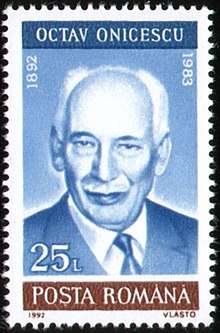Octav Onicescu
Octav Onicescu (Romanian pronunciation: [okˈtav oniˈt͡ʃesku]; August 20, 1892 – August 19, 1983) was a Romanian mathematician, member of the Romanian Academy, and founder of the Romanian school of probability theory and statistics.

Biography
He was born in Botoşani, the son of Vlad Onicescu, from Ștefănești, Botoșani, and Ana, from Oniceni, Neamţ County. He graduated from the Botoşani A. T. Laurian High School in 1911 with a perfect average grade of 10. That same year, he entered the University of Bucharest, from where he graduated with degrees in mathematics and philosophy in 1913. From 1914 to 1916 he was a mathematics teacher at the military gymnasium of Dealu Monastery, near Târgovişte. From 1916 to 1918 he fought in World War I.
In 1919, Onicescu went to study geometry at the University of Rome, under the guidance of Tullio Levi-Civita. He earned his Ph.D. in June, 1920 for a thesis titled Sopra gli spazi einsteiniani a gruppi continui di transformazione ("On Einstein manifolds and groups of continuous transformations"). The thesis, which dealt with problems in differential geometry related to Albert Einstein's theory of relativity, was defended in front of a jury of 11 mathematicians, including Levi-Civita, Vito Volterra, and Guido Castelnuovo.
In the Fall of 1920 he went to Paris, where he gave talks in Jacques Hadamard's seminar at the Collège de France. While in Paris, he organized a seminar with other Romanian mathematicians, including Petre Sergescu, Şerban Gheorghiu, Alexandru Pantazi, and Şerban Coculescu.
In 1922, he returned to Bucharest, where he embarked on a 40-year-long university career. In 1924, he started teaching the first college-level probability theory course in Romania. From 1928 on, he was professor at the Faculty of Sciences of the University of Bucharest, and was appointed full professor in 1931. In 1930, he organized the School of Statistics and established an Institute of Calculus, serving as its director for many years. In 1936 he entered the Legionary Movement. The Romanian poet and mathematician Ion Barbu (Dan Barbilian) was a close friend of his.
He was an Invited Speaker of the ICM in 1928 at Bologna[1] and in 1936 at Oslo. He was elected corresponding member of the Romanian Academy in 1933, and became full member on February 4, 1965. He was in charge of the Probability Theory section of the Institute of Mathematics of the Romanian Academy.
He died in Bucharest on the eve of his 91st birthday, after a short illness.
Legacy
Onicescu was one of the founders of the Balkan Union of Mathematicians (in 1934) and of the International Centre for Mechanical Sciences in Udine (in 1968).
The "Octav Onicescu" museum, founded in Botoşani in October 1995, houses furniture and memorabilia that belonged to him, including manuscripts, letters, diplomas, books, photographs, and military decorations. The memorial house doesn't exist anymore.
References
- (in Romanian) Biography, at the Octav Onicescu National College, in Bucharest
- Marius Iosifescu, "Octav Onicescu, 1892-1983", International Statistical Review, vol. 54, no. 1 (1986), pp. 97–108
- Christopher Charles Heyde and Eugene Seneta, "Statisticians of the Centuries", Springer, New York, 2006. ISBN 0-387-95329-9
- Onicescu, O. "La notion de saturation et le problème de Dirichlet." In Atti del Congresso Internazionale dei Matematici: Bologna del 3 al 10 de settembre di 1928, vol. 2, pp. 261–262. 1929.